Animal welfare or Corporate Greed? The Truth Behind Ambani’s Vantara
Shristy sinha | Mar 13, 2025, 22:09 IST
PM Modi and Anant Ambani at Vantara
Vantara, backed by the Ambani family, primarily aims to protect endangered wildlife while facing skepticism over its commercial expansion. Despite claims of genuine conservation efforts, critics fear the blending of business and animal welfare could jeopardize the sanctuary's ethical integrity. In the face of animal welfare, is Ambani trying to expand his mansion?
In recent years, the name "Vantara" has become synonymous with a high-profile project in India—one that intertwines animal conservation with the business interests of one of the country's wealthiest families. The initiative, which is backed by the Ambani family, particularly Anant Ambani, has garnered significant attention, sparking debates about whether its core mission genuinely aims to protect animals or if it is primarily driven by corporate greed. To understand this complex situation, we must examine Vantara's origin, its evolution, and the future plans envisioned by its creators.

Vantara, located in the coastal city of Jamnagar, Gujarat, was initially conceived with the mission of offering sanctuary to wildlife in distress. Launched by the Reliance Foundation under the leadership of Anant Ambani, the younger son of industrialist Mukesh Ambani, Vantara sought to create an environment where animals, particularly endangered species, could thrive away from human interference. The first goal of the project was clear: to ensure the welfare of animals in a natural habitat, provide medical care to those in need, and promote breeding programs for species on the brink of extinction.
The name "Vantara" itself was derived from a Sanskrit word, which loosely translates to "the embodiment of nature" or "the protector of all living beings." This signified its ambitious goal to not just rescue animals but to serve as a model of conservation that could inspire other such initiatives across the country and the world. Early reports surrounding Vantara focused on its conservation efforts, portraying it as a step forward for animal welfare in India. It quickly drew praise from environmentalists, animal rights groups, and conservationists, as it appeared to be a genuine effort to protect India's rich biodiversity.

However, as time passed, Vantara began to take on a new direction, one that raised eyebrows and sparked skepticism. What had initially been presented as an altruistic venture gradually morphed into a more business-oriented operation, heavily marketed as a luxury wildlife sanctuary.
One of the most significant turning points in Vantara’s evolution was its expansion strategy. Initially designed to focus on indigenous species, the sanctuary began to bring in animals from different parts of India, and soon, from across the world. This move was framed as a part of the sanctuary's larger goal of conserving global biodiversity, but it inevitably led to questions about its true purpose.
Reports surfaced that Vantara was acquiring rare and exotic animals, including those from far-flung corners of Africa and Southeast Asia, making it one of the most extensive and diverse wildlife sanctuaries in the country. While this undoubtedly drew attention to the project, it also gave rise to concerns that Vantara was transforming into a commercial enterprise rather than a solely conservation-focused initiative. Critics began to question whether the sanctuary’s expansion was less about animal welfare and more about creating a profitable business model that capitalized on the allure of rare species.
For instance, bringing animals from different regions of India, like tigers from Rajasthan or elephants from Assam, into Jamnagar raised concerns regarding the ethical implications of removing these creatures from their native habitats. In some cases, the long-distance relocation of animals across vast geographical spaces could potentially cause stress, harm, or lead to survival challenges for those unfamiliar with the new environment.
Even more troubling were reports about the exotic species being brought in from foreign countries. Some animal rights advocates worried that this practice might be viewed as a form of commodification, where the value of the animals was based on their rarity or prestige rather than their well-being. Critics pointed to Vantara's branding as a "luxury wildlife sanctuary," suggesting that it might be capitalizing on the popularity of rare animals and their appeal to affluent clientele, potentially turning wildlife conservation into a lucrative business venture.
The Future of Vantara: Anant Ambani’s Vision

Despite the growing concerns, Anant Ambani and the Ambani family have consistently emphasized their commitment to animal welfare. Anant, who has been particularly vocal about his passion for wildlife conservation, has outlined an ambitious roadmap for Vantara's future. According to him, the sanctuary is not just a facility for endangered species but will serve as a hub for education, research, and global collaboration on conservation issues.
One of the key elements of the future plan for Vantara involves establishing a state-of-the-art breeding program aimed at preventing the extinction of several critically endangered species. Anant Ambani has suggested that this would involve collaborating with international conservation bodies to ensure that the sanctuary operates under the highest standards of ethical wildlife management.
Furthermore, Vantara plans to diversify its efforts by creating an ecosystem that blends conservation with sustainable tourism. The sanctuary intends to offer a controlled, yet immersive, experience for visitors, allowing them to witness wildlife in its natural habitat. Anant has emphasized that this would be done in a manner that minimizes disturbance to the animals and promotes awareness about the importance of conservation.
But with these future plans also comes a continuing cloud of skepticism. Many critics worry that the commercialization of Vantara will only intensify as it attracts wealthier individuals and corporate sponsors who may have ulterior motives. The intertwining of luxury and wildlife conservation could present challenges in terms of the ethical treatment of animals and the long-term sustainability of the sanctuary’s mission.

At its core, Vantara’s journey reflects the complex intersection of animal welfare and business interests. While the sanctuary undeniably plays a crucial role in protecting endangered species and educating the public about the importance of conservation, its transformation from a solely animal welfare initiative to a more commercialized venture has raised legitimate questions.
The future of Vantara hinges on how it navigates this fine line between preserving the integrity of its mission and maximizing its potential for growth. If the Ambani family, particularly Anant, can strike a balance between genuine conservation efforts and responsible business practices, Vantara could serve as a model for sustainable wildlife protection in the modern age. However, if the drive for profitability outweighs the sanctity of animal welfare, Vantara could be seen as yet another example of how corporate greed can take precedence over ethical concerns.
Ultimately, only time will tell whether Vantara’s evolution will be a boon for conservation, or a cautionary tale of how good intentions can sometimes give way to more self-serving interests. What is clear, however, is that Vantara's story is far from over, and it will continue to be a subject of intense debate in the years to come.
The Birth of Vantara: A Mission to Protect Animals

Treatment of an Elephant at Vantara
Vantara, located in the coastal city of Jamnagar, Gujarat, was initially conceived with the mission of offering sanctuary to wildlife in distress. Launched by the Reliance Foundation under the leadership of Anant Ambani, the younger son of industrialist Mukesh Ambani, Vantara sought to create an environment where animals, particularly endangered species, could thrive away from human interference. The first goal of the project was clear: to ensure the welfare of animals in a natural habitat, provide medical care to those in need, and promote breeding programs for species on the brink of extinction.
The name "Vantara" itself was derived from a Sanskrit word, which loosely translates to "the embodiment of nature" or "the protector of all living beings." This signified its ambitious goal to not just rescue animals but to serve as a model of conservation that could inspire other such initiatives across the country and the world. Early reports surrounding Vantara focused on its conservation efforts, portraying it as a step forward for animal welfare in India. It quickly drew praise from environmentalists, animal rights groups, and conservationists, as it appeared to be a genuine effort to protect India's rich biodiversity.
The Shift Towards Business and Expansion

Vantara
However, as time passed, Vantara began to take on a new direction, one that raised eyebrows and sparked skepticism. What had initially been presented as an altruistic venture gradually morphed into a more business-oriented operation, heavily marketed as a luxury wildlife sanctuary.
One of the most significant turning points in Vantara’s evolution was its expansion strategy. Initially designed to focus on indigenous species, the sanctuary began to bring in animals from different parts of India, and soon, from across the world. This move was framed as a part of the sanctuary's larger goal of conserving global biodiversity, but it inevitably led to questions about its true purpose.
Reports surfaced that Vantara was acquiring rare and exotic animals, including those from far-flung corners of Africa and Southeast Asia, making it one of the most extensive and diverse wildlife sanctuaries in the country. While this undoubtedly drew attention to the project, it also gave rise to concerns that Vantara was transforming into a commercial enterprise rather than a solely conservation-focused initiative. Critics began to question whether the sanctuary’s expansion was less about animal welfare and more about creating a profitable business model that capitalized on the allure of rare species.
For instance, bringing animals from different regions of India, like tigers from Rajasthan or elephants from Assam, into Jamnagar raised concerns regarding the ethical implications of removing these creatures from their native habitats. In some cases, the long-distance relocation of animals across vast geographical spaces could potentially cause stress, harm, or lead to survival challenges for those unfamiliar with the new environment.
Even more troubling were reports about the exotic species being brought in from foreign countries. Some animal rights advocates worried that this practice might be viewed as a form of commodification, where the value of the animals was based on their rarity or prestige rather than their well-being. Critics pointed to Vantara's branding as a "luxury wildlife sanctuary," suggesting that it might be capitalizing on the popularity of rare animals and their appeal to affluent clientele, potentially turning wildlife conservation into a lucrative business venture.
The Future of Vantara: Anant Ambani’s Vision

Anant ambani.
Despite the growing concerns, Anant Ambani and the Ambani family have consistently emphasized their commitment to animal welfare. Anant, who has been particularly vocal about his passion for wildlife conservation, has outlined an ambitious roadmap for Vantara's future. According to him, the sanctuary is not just a facility for endangered species but will serve as a hub for education, research, and global collaboration on conservation issues.
One of the key elements of the future plan for Vantara involves establishing a state-of-the-art breeding program aimed at preventing the extinction of several critically endangered species. Anant Ambani has suggested that this would involve collaborating with international conservation bodies to ensure that the sanctuary operates under the highest standards of ethical wildlife management.
Furthermore, Vantara plans to diversify its efforts by creating an ecosystem that blends conservation with sustainable tourism. The sanctuary intends to offer a controlled, yet immersive, experience for visitors, allowing them to witness wildlife in its natural habitat. Anant has emphasized that this would be done in a manner that minimizes disturbance to the animals and promotes awareness about the importance of conservation.
But with these future plans also comes a continuing cloud of skepticism. Many critics worry that the commercialization of Vantara will only intensify as it attracts wealthier individuals and corporate sponsors who may have ulterior motives. The intertwining of luxury and wildlife conservation could present challenges in terms of the ethical treatment of animals and the long-term sustainability of the sanctuary’s mission.
Conclusion: A Fine Line Between Welfare and Greed

Anant Ambani with elephants.
At its core, Vantara’s journey reflects the complex intersection of animal welfare and business interests. While the sanctuary undeniably plays a crucial role in protecting endangered species and educating the public about the importance of conservation, its transformation from a solely animal welfare initiative to a more commercialized venture has raised legitimate questions.
The future of Vantara hinges on how it navigates this fine line between preserving the integrity of its mission and maximizing its potential for growth. If the Ambani family, particularly Anant, can strike a balance between genuine conservation efforts and responsible business practices, Vantara could serve as a model for sustainable wildlife protection in the modern age. However, if the drive for profitability outweighs the sanctity of animal welfare, Vantara could be seen as yet another example of how corporate greed can take precedence over ethical concerns.
Ultimately, only time will tell whether Vantara’s evolution will be a boon for conservation, or a cautionary tale of how good intentions can sometimes give way to more self-serving interests. What is clear, however, is that Vantara's story is far from over, and it will continue to be a subject of intense debate in the years to come.
